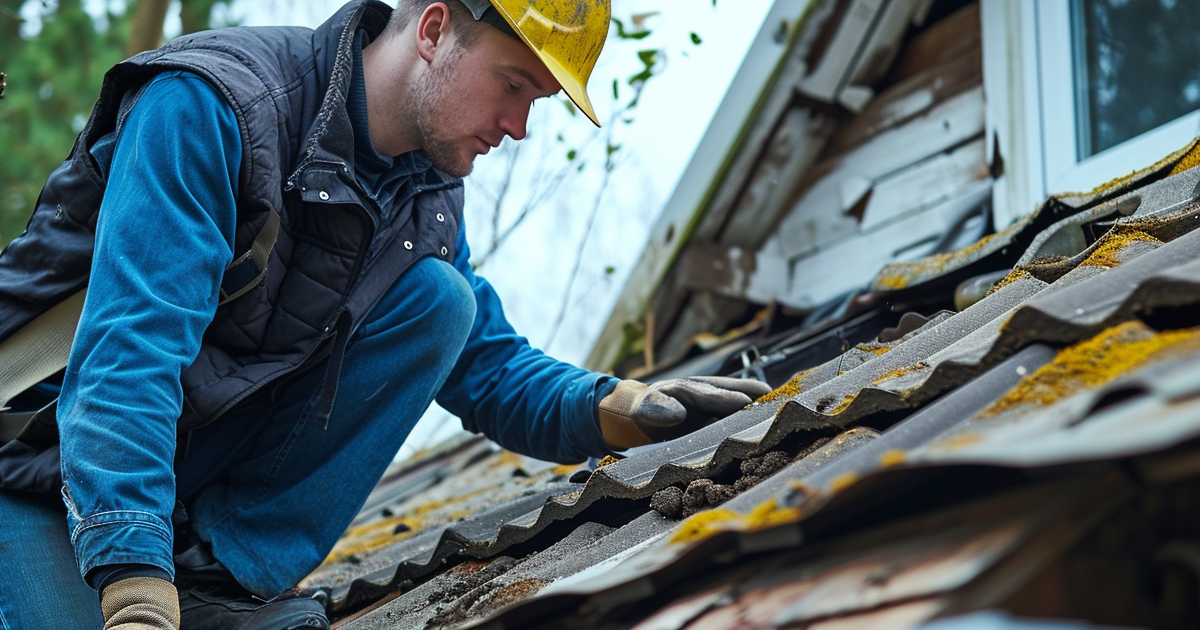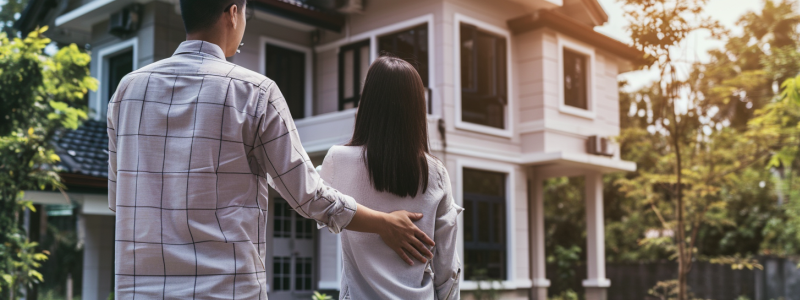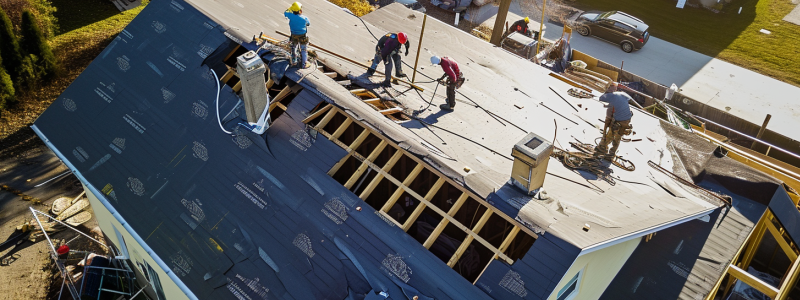
Things to Consider When Replacing a Roof
For both homeowners and business owners, the roof serves as a fundamental shield, safeguarding the interior of your property from weather extremes and environmental elements. Its role extends beyond mere protection; a well-maintained roof contributes to energy efficiency, enhances the aesthetic appeal of your property, and plays a significant part in determining its overall value. However, the decision to replace a roof is not one to be taken lightly. In this comprehensive guide, we will explore the key aspects of “Things to consider when replacing a roof.”
This article is tailored for individuals who may not have extensive knowledge about roofing but are facing the need to make this crucial decision. We aim to provide clear, authoritative information that demystifies the process, helping you navigate through the myriad of choices and considerations with confidence.
We will discuss various factors such as understanding your specific roofing needs, choosing the right materials, finding a qualified contractor, budgeting effectively, comprehending the replacement process, and ensuring long-term maintenance and care. Each of these elements plays a vital role in not only ensuring a successful roof replacement but also in securing the longevity and effectiveness of your investment.

Understanding Your Roofing Needs
When contemplating a roof replacement, the first step is to thoroughly understand your specific roofing needs. This understanding is crucial in ensuring that the new roof not only addresses current issues but also aligns with your long-term requirements. Here are key factors to consider:
- Current Roof Condition: Examine the age and state of your existing roof. Look for signs of wear such as missing shingles, leaks, or frequent repairs. Understanding the extent of damage or deterioration helps in deciding whether a repair or a complete replacement is necessary.
- Climate Considerations: Your local climate plays a significant role in determining the suitable roofing material. For instance, areas with heavy snowfall require a sturdy roof, while hot climates might benefit from reflective roofing materials to enhance energy efficiency.
- Building Use and Requirements: The purpose of your building influences your roofing choice. A commercial building might have different roofing needs compared to a residential property. Consider factors like insulation, load-bearing capacity, and ventilation.
- Aesthetic Preferences: The appearance of your roof impacts the overall look of your property. Consider the architectural style of your building and your personal preferences when selecting materials and designs.
- Future Plans: Think about your long-term plans for the property. If you intend to sell in the near future, you might prioritize curb appeal and resale value. For long-term ownership, durability and maintenance requirements become more important.
By carefully evaluating these aspects, you can gain a clearer understanding of what you need from your new roof. This initial assessment is a critical step in ensuring that your roof replacement aligns with both your immediate needs and future goals, setting the foundation for the subsequent steps in the roof replacement process.
Choosing the Right Materials
The choice of roofing materials is a pivotal decision in the roof replacement process. It affects not only the appearance and durability of your roof but also its cost and maintenance requirements. Here’s a guide to help you navigate through the options:
- Asphalt Shingles:
- Pros: Cost-effective, widely available, and come in various colors and styles.
- Cons: Shorter lifespan compared to some other materials; not as durable in extreme weather conditions.
- Metal Roofing:
- Pros: Long-lasting, energy-efficient, and can withstand severe weather. Ideal for areas with heavy snowfall or high winds.
- Cons: Higher initial cost; installation requires specialized skills.
- Tile Roofing (Clay or Concrete):
- Pros: Extremely durable, fire-resistant, and offers a unique aesthetic appeal.
- Cons: Heavy, requiring strong structural support; more expensive than asphalt.
- Slate Roofing:
- Pros: Offers a distinctive look with excellent durability and a long lifespan.
- Cons: Among the most expensive; heavy and requires a reinforced roof structure.
- Wood Shingles or Shakes:
- Pros: Natural appearance, with some energy-efficient properties.
- Cons: Requires regular maintenance; not ideal in fire-prone areas.
- Synthetic Roofing Materials:
-
- Pros: Can mimic the look of wood, slate, or tile; often lighter and less expensive.
- Cons: Varying quality; newer on the market, so longevity is less proven.
When thinking about “Things to Consider When Replacing a Roof”, and while selecting roofing materials, you should consider factors such as your budget, the climate in your area, the architectural style of your property, and maintenance requirements. It’s also important to think about the long-term implications of your choice, such as the lifespan of the material and any ongoing maintenance needs.
Finding a Qualified Contractor
The selection of a qualified roofing contractor is a crucial step in the roof replacement process. A skilled and reliable contractor ensures that your roof is installed correctly, adhering to safety standards and industry best practices. Here are key points to consider when choosing a roofing contractor:
- Check Credentials and Experience:
- Look for contractors with a solid track record and ample experience in roof replacement.
- Ensure they are licensed and insured, providing protection against accidents or damage.
- Read Reviews and Seek References:
- Check online reviews and ask for references from past clients.
- This step provides insights into the contractor’s reliability, quality of work, and customer service.
- Get Multiple Quotes:
- Obtain quotes from several contractors to compare prices and services.
- Remember, the cheapest option is not always the best. Quality and reliability are paramount.
- Ask About Warranties and Guarantees:
- Inquire about the warranties offered on both materials and workmanship.
- A good contractor stands behind their work with substantial warranties.
- Communication is Key:
- Choose a contractor who communicates clearly and promptly.
- Good communication throughout the project is essential for a smooth process.
- Local Knowledge and Compliance:
- A local contractor will be familiar with regional weather conditions and building codes.
- They can provide tailored advice and ensure compliance with local regulations.
Selecting the right contractor is a significant aspect of “Things to consider when replacing a roof.” A competent contractor not only brings expertise to your project but also peace of mind, knowing that your investment is in good hands. Take the time to research and choose a contractor who meets these criteria to ensure a successful and satisfactory roof replacement experience.

Budgeting for Your Roof Replacement
Budgeting effectively for a roof replacement is a critical component of the project. It involves understanding the costs and planning your finances to ensure the project is both affordable and of high quality. Here are essential points to consider for budgeting:
- Understand the Cost Factors:
- Roof size, material choice, labor, and any additional repairs or structural changes significantly influence the overall cost.
- Be aware that higher-quality materials and experienced labor might cost more upfront but can offer better longevity and value.
- Get Detailed Estimates:
- Obtain itemized estimates from contractors to understand where your money is going.
- This transparency helps in comparing quotes and ensuring you are paying for necessary services.
- Plan for Unexpected Expenses:
- Set aside a contingency fund, typically 10-20% of the project cost, for unforeseen issues like structural repairs.
- Roof replacements can reveal hidden problems that need addressing.
- Explore Financing Options:
- If paying upfront is challenging, consider financing options like loans or payment plans offered by contractors.
- Research and compare different financing options to find one that suits your financial situation.
- Consider Long-term Savings:
- Investing in energy-efficient materials or durable roofing can lead to long-term savings through reduced energy bills and maintenance costs.
- Evaluate the long-term financial benefits alongside the initial investment.
- Check for Rebates and Incentives:
- Some regions offer rebates, tax credits, or incentives for using certain materials or for energy-efficient upgrades.
- Research local programs that might help offset some of the costs.
A well-planned budget ensures that you can afford a quality roof replacement without financial strain. It also helps in making informed decisions about materials and contractors, balancing cost with quality and long-term benefits. By carefully planning your finances, you can invest in a roof that not only protects your property but also adds value to it.
Long-term Maintenance and Care
After successfully replacing your roof, it’s important to focus on long-term maintenance and care to ensure its longevity and optimal performance. Regular maintenance not only extends the life of your roof but also helps in identifying potential issues before they become major problems. Here are key strategies for maintaining your new roof:
- Regular Inspections:
- Schedule professional inspections at least once a year, ideally after severe weather seasons.
- Regular inspections help in detecting minor damages or wear and can prevent costly repairs.
- Keep the Roof Clean:
- Remove debris like leaves, branches, and dirt that can accumulate over time.
- Debris can trap moisture, leading to rot or mold, and can block drainage systems.
- Gutter Maintenance:
- Keep gutters and downspouts clean and clear of obstructions.
- Properly functioning gutters are essential for water drainage and preventing water damage.
- Monitor for Damage:
- Be vigilant for signs of damage, such as missing or broken shingles, leaks, or cracks.
- Early detection and repair of these issues can prevent more extensive damage.
- Trim Overhanging Tree Branches:
- Regularly trim branches that hang over your roof.
- This reduces the risk of damage from falling branches and minimizes debris accumulation.
- Ventilation and Insulation:
- Ensure your attic is well-ventilated and properly insulated.
- Good ventilation and insulation prevent heat and moisture buildup, which can damage your roof over time.
- Address Issues Promptly:
- If you notice any problems, address them promptly to prevent further damage.
- Delaying repairs can lead to more extensive and expensive issues.
By investing time and resources in regular maintenance, you can protect your investment and ensure that your roof remains in excellent condition for years to come. A well-maintained roof not only provides security and protection but also adds to the aesthetic and functional value of your property.

Ready to Start Your Roof Replacement Journey?
If you’re pondering over the topic of “Things to Consider When Replacing a Roof”, consider reaching out to expert guidance, B&M Roofing is here to help. With our team of experienced professionals, we ensure a seamless and high-quality roof replacement experience. Visit B&M Roofing today to schedule a consultation and take the first step towards a durable, aesthetically pleasing, and long-lasting roof for your property.




































